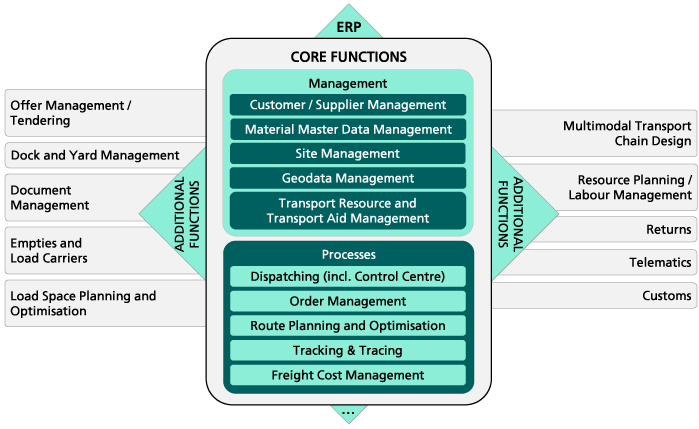Definition Transport Management System
What is a Transport Management System?
A Transport Management System (TMS) is used to plan, execute and optimise transport processes in external logistics. In addition to CEP vehicles and trucks, the means of transport used can also include ships, railways or aircrafts. The TMS supports the orchestration of transports by recording and managing transport orders, planning routes, optimising the loading of the means of transport and calculating the costs arising in connection with the transports. In addition, shipments can be tracked and invoiced, including using telematics. Information obtained in this way can be passed on in real time by connecting to adjacent systems, e.g. the WMS.
The implementation of a Transport Management System increases transparency along the supply chain and enables improved control of inventory management.
Due to its diverse functions, a Transport Management System is suitable for use both in companies that deliver their goods independently and for use by transport service providers.
Functionality of a TMS

The majority of TMS users want a customised standard TMS, i.e. the TMS should functionally cover the individual business processes without being an (expensive) individual solution. Suppliers try to meet this demand by developing systems that have a modular structure, can be parameterised (by the customer) and have defined programme routines that integrate individually programmed functions into the system.
A modern TMS has a modular structure, whereby the individual functions can be summarised as core and additional functions as well as expansion modules. This enables the customer to install only the required modules and not the entire TMS. If an extension of the functionality is necessary in the future to provide functional support for new task areas, the required modules are added to the existing system and activated; according to the provider, this should work smoothly. The customer usually only pays for the required functionality.
A standard TMS has all functions necessary for planning and controlling inter-company transport processes. Fraunhofer IML counts the core functions including functional support from order entry to goods delivery among these.
Basically, the user defines the scope of the TMS. Any function that the user deems necessary is part of his TMS.
Core Functions
The core functions belong to the ordinary functional area of each TMS. They are indispensable for the operation of the TMS and belong to the minimum installation scope of each system. A few core functions are also offered separately by specialists as stand-alone modules, but usually the core functions are supported exclusively by modules from the TMS provider. The core functions support the main application area of each TMS: from order acceptance to transport execution.
Additional Functions
The additional functions are also part of the usual functional range of each TMS, but are only installed if the customer also requires the corresponding functionality. There are also modules for the additional functions, e.g. dock and yard management as well as the management of empties and load carriers, which are offered separately by specialist companies and linked to the TMS via an interface. Usually, however, the additional functions are part of the standard package offered by the TMS provider.
Expansion Modules
Extension modules, e.g. apps for mobile devices, are usually independent software packages that extend the functional scope of a TMS or optimise the workflows during transport.
